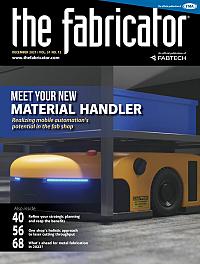Field Tech Support Specialist
- FMA
- The Fabricator
- FABTECH
- Canadian Metalworking
Categories
- Additive Manufacturing
- Aluminum Welding
- Arc Welding
- Assembly and Joining
- Automation and Robotics
- Bending and Forming
- Consumables
- Cutting and Weld Prep
- Electric Vehicles
- En Español
- Finishing
- Hydroforming
- Laser Cutting
- Laser Welding
- Machining
- Manufacturing Software
- Materials Handling
- Metals/Materials
- Oxyfuel Cutting
- Plasma Cutting
- Power Tools
- Punching and Other Holemaking
- Roll Forming
- Safety
- Sawing
- Shearing
- Shop Management
- Testing and Measuring
- Tube and Pipe Fabrication
- Tube and Pipe Production
- Waterjet Cutting
Industry Directory
Webcasts
Podcasts
FAB 40
Advertise
Subscribe
Account Login
Search
8 ways to reduce the cost for welding operations
How to optimize consumable, gun, equipment, and operator performance in semiautomatic and robotic welding
- By Roger Robey and Seth Perrin
- Updated May 5, 2023
- December 6, 2021
- Article
- Automation and Robotics

With some consumable platforms, semiautomatic and robotic weld cells can use the same contact tips, which helps streamline inventory and reduce operator confusion about which are the right ones to use.
Cost overruns in a manufacturing welding operation can come from many places. Whether it’s a semiautomatic or robotic weld cell, some common causes of unnecessary costs are unplanned downtime and lost labor, consumable waste, repairs and rework, and lack of operator training.
Many of these factors are tied together and influence each other. A lack of operator training, for example, can result in more weld defects that require rework and repair. Not only do repairs cost money in additional materials and consumables used, but they also require more labor to do the work and any additional weld testing.
Repairs can be especially costly in an automated welding environment, where constant progression of the part is crucial to overall throughput. If a part isn’t welded correctly and that defect isn’t caught until the end of the process, all the work must be redone.
Companies can use these eight tips to help optimize consumable, gun, and equipment performance and reduce costs in both semiautomatic and robotic welding operations.
1. Don’t Change Consumables Too Soon
Consumables, including the nozzle, diffuser, contact tip, and liners, can make up a significant part of the cost in manufacturing operations. Some operators may change the contact tip after every shift simply out of habit, whether it’s necessary or not. But changing consumables too soon can waste hundreds, if not thousands, of dollars a year. Not only does this shorten the usable life, but it also adds operator downtime for unnecessary changeover.
It’s also common for operators to change the contact tip when they experience wire feeding problems or other gas metal arc welding (GMAW) gun performance issues. But the problem usually lies with an improperly trimmed or installed gun liner. Liners that are not retained on both ends of the gun tend to cause issues as the gun cable stretches over time. If contact tips seem to fail faster than normal, it could also be caused by improper drive roll tension, worn drive rolls, or feeder pathways keyholing.
Proper operator training regarding consumable life and changeover can help prevent unnecessary changeover, saving time and money. Also, this is an area of the welding operation where time studies are especially helpful. Knowing how often a consumable should last gives the welders a much better idea of when they truly need to change it.
2. Control Consumable Usage to Reduce the Cost of Welding
To avoid premature consumable changeover, some companies implement steps to control their usage. Storing the consumables near the welders, for example, helps reduce downtime incurred when traveling to and from a central parts storage area.
Also, limiting the inventory that’s accessible to welders prevents wasteful usage. This allows whoever is refilling these part bins to have a much better understanding of the shop’s consumable usage.
3. Match the Equipment and Gun to the Weld Cell Setup
Having the proper length of semiautomatic GMAW gun cable for the weld cell configuration promotes operator efficiency and optimizes equipment performance.
If it’s a smaller cell where everything is close to where the welder is working, having a 25-ft. gun cable coiled up on the floor can cause issues with wire feeding and even voltage drop at the tip, plus it creates a tripping hazard. Conversely, if the cable is too short, the welder may be prone to pulling the gun, putting stress on the cable and its connection to the gun.
4. Choose the Best Consumables for the Job
While it’s tempting to buy the cheapest contact tips, nozzles, and gas diffusers available, they typically don’t last as long as high-quality products, and they cost more in labor and downtime due to more frequent changeover. Shops shouldn’t be afraid to test different products and run documented trials to find the best options.
When a shop finds the best consumables, it can save time in inventory management by using the same ones across all welding operations in the facility. With some consumable platforms, semiautomatic and robotic weld cells can use the same contact tips, which helps streamline inventory and reduce operator confusion about which are the right ones to use.
5. Build in Preventive Maintenance Time into the Price of Welding
It’s always better to be proactive than reactive. Downtime should be scheduled to conduct preventive maintenance, perhaps daily or weekly. This helps keep the production line flowing smoothly and reduces time and costs spent on unplanned maintenance.
Companies should create standards of practice to outline procedures for the human operator or robot operator to follow. In automated weld cells specifically, a reamer or nozzle cleaning station will remove spatter. It can prolong consumable life and reduce human interaction with the robot. This helps minimize costs caused by human interaction that could introduce errors and result in downtime. In semiautomatic operations, checking components such as the cable cover, handles, and necks for damage can save downtime later. GMAW guns featuring a durable cable covering are a great way to increase life of the product and reduce potentially harmful situations for employees. In semiautomatic welding applications, selecting a repairable GMAW gun rather than one that needs to be replaced also can save time and money.
6. Invest in New Technology
Rather than making do with outdated welding power sources, shops can invest in new machines with improved technologies. They will likely be more productive, need less maintenance, and be easier to find parts for—ultimately proving more cost-efficient.
For example, a pulsed welding waveform provides a more stable arc and creates less spatter, which reduces the amount of time spent on cleanup. And new technology isn’t limited to power sources. Today’s consumables offer technologies that help promote longer life and reduce changeover time. Robotic welding systems also can implement touch sensing to help with part location.
7. Consider Shielding Gas Selection to Reduce Welding Costs
Shielding gas is an often-overlooked factor in welding. Newer technology has resolved issues with gas delivery so that lower gas flow rates—35 to 40 cubic feet per hour (CFH)—can produce the same quality that used to require 60- to 65-CFH gas flow. This lower shielding gas usage can result in significant cost savings.
Also, shops should be aware that the type of shielding gas affects factors like spatter and cleanup time. For example, a 100% carbon dioxide gas provides great penetration, but it produces more spatter than a mixed gas. Testing different shielding gases to see which one provides the best results for the application is recommended.
8. Improve the Environment to Attract and Retain Skilled Welders
Employee retention plays a big role in cost savings. High turnover necessitates continuous employee training, which is a waste of time and money. One way to attract and keep skilled workers is by improving a shop’s culture and environment. Technology has changed, as have people’s expectations of their work environment, and companies must adapt.
A clean, temperature-controlled facility with fume-extraction systems is inviting to employees. Perks like attractive welding helmets and gloves also can be an incentive. It’s also important to invest in proper employee training, which will help newer welders better understand the process so they can troubleshoot problems. Investing in employees pays off in the long run.
With properly trained welders using the right equipment and consumables for the job, and production lines that are continuously fed with few disruptions for rework or consumable changeover, shops can keep their welding processes moving while reducing unnecessary costs.
About the Authors

Seth Perrin
Advanced Welding Product Specialist
449 W. Corning Rd.
Beecher, IL 60401
(708)-946-2281
Related Companies
subscribe now

The Fabricator is North America's leading magazine for the metal forming and fabricating industry. The magazine delivers the news, technical articles, and case histories that enable fabricators to do their jobs more efficiently. The Fabricator has served the industry since 1970.
start your free subscription- Stay connected from anywhere

Easily access valuable industry resources now with full access to the digital edition of The Fabricator.

Easily access valuable industry resources now with full access to the digital edition of The Welder.

Easily access valuable industry resources now with full access to the digital edition of The Tube and Pipe Journal.
- Podcasting
- Podcast:
- The Fabricator Podcast
- Published:
- 04/16/2024
- Running Time:
- 63:29
In this episode of The Fabricator Podcast, Caleb Chamberlain, co-founder and CEO of OSH Cut, discusses his company’s...
- Trending Articles
Capturing, recording equipment inspection data for FMEA

Tips for creating sheet metal tubes with perforations

Are two heads better than one in fiber laser cutting?

Supporting the metal fabricating industry through FMA

Omco Solar opens second Alabama manufacturing facility

- Industry Events
16th Annual Safety Conference
- April 30 - May 1, 2024
- Elgin,
Pipe and Tube Conference
- May 21 - 22, 2024
- Omaha, NE
World-Class Roll Forming Workshop
- June 5 - 6, 2024
- Louisville, KY
Advanced Laser Application Workshop
- June 25 - 27, 2024
- Novi, MI


























